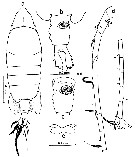|
|
 |
|
Calanoida ( Order ) |
|
|
|
Diaptomoidea ( Superfamily ) |
|
|
|
Tortanidae ( Family ) |
|
|
|
Tortanus ( Genus ) |
|
|
|
Atortus ( Sub-Genus ) |
|
|
| |
Tortanus (Atortus) bilobus Mulyadi, Nishida & Ohtsuka, 2017 (F,M) | |
| | | | | | | Ref.: | | | Mulyadi, Nishida & Ohtsuka, 2017 (p. 85, Descr. F,M, figs. F,M, Rem.) |  Issued from: Mulyadi, S. Nishida & S. Ohtsuka in Crustaceana, 2017, 90 (1). [p.86, Fig.4]. Female (from 1°24.265'N, 125°07.219'E): a, habitus (dorsal); b, urosome (ventral); c, genital compound somite (ventral); d, A1; e, P5. Nota: - Prosome about 3.5 times as long as urosome . - Posterior corners of prosome produced into asymmetrycal, roundedlobes, left corner wider and produced more posteriorly than right. - Urosome 2-segmented. - Anal somite coalescent with caudal rami. - Genital compound somite elongated, left margin irregular with spinule near posterior 1/4, right margin with 2 obtuse processes; genital operculum oval, located at anterior 1/3. - Caudal rami asymmetrical, left ramus longer than right/ - A1, A3, Mx1, Mx2, Mxp and P1-P4 similar to those in female T. (A.) sulawesiensis. - P5 rudimentary; proximal segments of right and left legs fused to form common base; apical segment lamellar and subquadrate with distolateral seta.
|
 Issued from: Mulyadi, S. Nishida & S. Ohtsuka in Crustaceana, 2017, 90 (1). [p.87, Fig.5]. Male: a, habitus (dorsal); b, right A1 (number of ancestral segment indicated by Roman numerals); c, P5. Nota: - Prosome 2.7 times as long as urosome. - Posterior corners produced into asymmetrical, rounded lobes, left lobe wider and produced mote posteriorly than right. - Genital somite asymmetrical, left side produced posteriorly. - Right margin of urosomite 2 withot any process. - appendages as in male T. (A.) sulawesiensis, except right A1 and P5. - Right A1 serrate of segment XX produced proximally to midlength of segment XIX; anteroproximal process on segment XIX slender, reaching midjoint of segment. - P5: Right leg coxa broad without ornament; basis bearing semi-trapezoid medial process with 2 setules along proximal margin, distal half of segment broadened; exopod straight on outer margin and slightly concave at middle part of medial margin, furnishing with 1 proximal outer spine and 3 spines on inner margin. Left leg coxa unarmed; basis elongate with mid-lateral seta and proximally 3 semicircular processes, proximal one with terminal setule; exopodal segment 1 wuth mediazl spinule located at proximal 1/4 of segment; exopodal segment 2 medial mazrgin with basal and sub-distal setae and terminal spine, tip of segment lamellate.
| | | | | NZ: | 1 | | |
|
Distribution map of Tortanus (Atortus) bilobus by geographical zones
|
| | | | Loc: | | | Indonesia (off Tanjung Merah, Sulawesi Is.).
Type locality: 1°24.265' N, 125°07219' E. | | | | N: | 1 | | | | Lg.: | | | (1314) F: 1,97-2,11; M: 1,58-1,61; {F: 1,97-2,11; M: 1,58-1,61} | | | | Rem.: | After Mulyadi & al. (2017, p.85), female P5 (simple, sub-quadrate) and the male A1 (serrate process on segment XX extending to segment XIX) of T. (A.) bilobus are in accordance with those of the brevipes species complex, but the male Ur2 (absence of lateral process on right side) corresponds to the recticauda species complex. The new species thus has a mixture of both species complexes. Accordingly, it is impossible to assign this species to either of the two groups. Nevertheless, T. (A.) bilobus is distinguished from the other species of Tortanus (Atortus) by the combination of features in the A1 and Ur2 as above in the male, and the characteristic shape of the genital compound somite in the female. | | | Last update : 05/04/2018 | |
|
|
 Any use of this site for a publication will be mentioned with the following reference : Any use of this site for a publication will be mentioned with the following reference :
Razouls C., Desreumaux N., Kouwenberg J. and de Bovée F., 2005-2025. - Biodiversity of Marine Planktonic Copepods (morphology, geographical distribution and biological data). Sorbonne University, CNRS. Available at http://copepodes.obs-banyuls.fr/en [Accessed October 21, 2025] © copyright 2005-2025 Sorbonne University, CNRS
|
|
 |
 |





